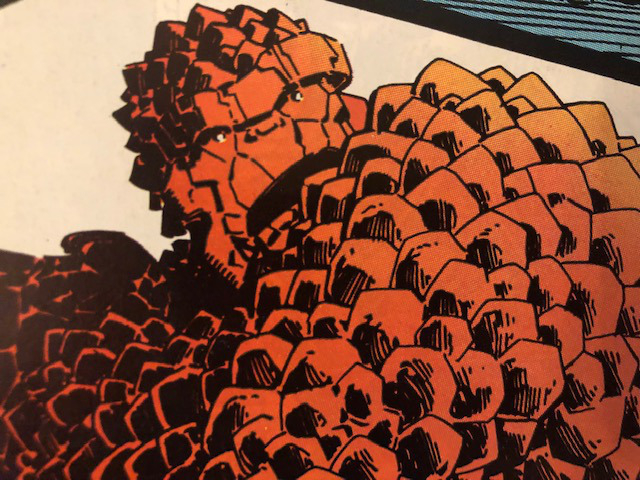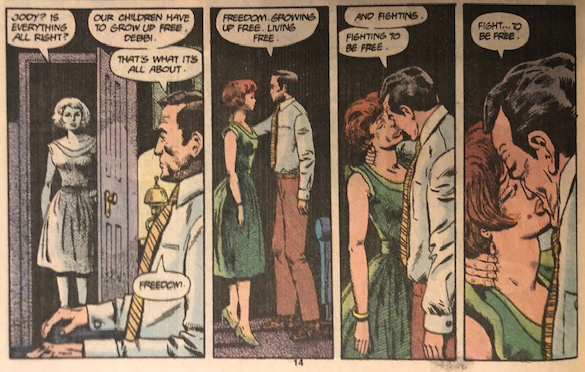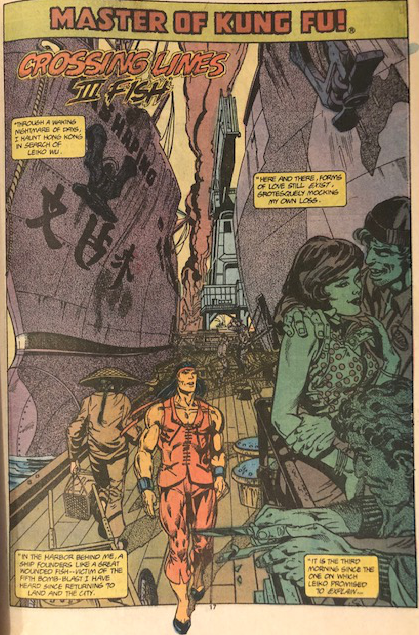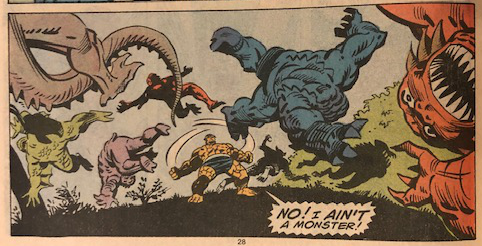
Marvel Comics Presents ran for 175 issues from 1988 until 1995. Each issue included four eight-page stories with typically two or three on-going features (and no ads). It spotlighted some of the leading creators of mainstream comics over a period of precipitous economic growth and even more rapid decline. Reading through it is an opportunity to revisit any number of weird aspects of 90s superhero comics. This blog is a primitive, oddly regimented, manifestly scattershot crawl through an often disappointing but occasionally splendid comic. All image copyrights are Marvel's. Issue credits linked below. Updated on Wednesdays.
Marvel Comics Presents #3:1988(10.09.19)
Credits: comicbookdb
This John Romita Jr cover marks the first inclusion of narrative elements in the front design and takes us beyond all-purpose character posing. It's not especially successful, leaving Logan (rather than a fully costumed Wolverine) looking more contorted than conflicted thought it probably marks a kind of Romita Jr transition point between the Daredevil work and the more volumetric style he'll wield in subsequent books like the Cable mini. More specific narrative elements are injected into the back cover's Man-Thing, but there's some prize shadow details on a lovely, pangolin/hedgehog-textured Thing.

A. Wolverine, "Save the Tiger" [3/10]
Wolverine scraps with Jessan Hoan and we're privy to her fairly nonsensical background from Outback-era Uncanny X-Men. The stage gets set here for a Razor Fist/Wolverine showdown, but the real stars here are Buscema and especially Janson's efforts to build out the space and atmosphere of Madripoor. The back alleys and streets are simultaneously slick, grimy, and pastel, which pairs nicely with the convivial rather than overwrought tone that Claremont strikes in Logan's monologue. There's now a few too many moving pieces for this story to sustain the pleasant noir detective beats and, worse still, we're now fretfully deep in X-continuity. That said, the bizarre physicality of Razor Fist is enough to center the story in the narrative present. After all, Wolverine's contending with a dude with straight up knives for hands.

B. Man-Thing, "Elements of Terror" [3/12]
The story is fraying apart into four threads: a body horror comeuppance for a senator, a doomed journalist, an eerie crypto-fascist bureaucrat, and Man-Thing bumbling into a witch's ritual. The artistic energy is reserved for the first and fourth of these, but Gerber's dialogue about "freedom" and the eerie emptiness of "freedom first" rhetoric is a fairly deft touch. The Sutton panels don't have much room to breath, but the close-up details and energy are carrying things along to what seems like a potentially interesting narrative moment. Again, Gerber has the ins and outs of Man-Thing down pat, making explicit the narrative (near) paradox that (a) Man-Thing burns the fearful and (b) who's going to be more fearful than someone unexpectedbly bumping into Man-Thing? Fun, icky stuff here.

C. Shang-Chi, "Crossing Lines" [3/8]
More like "Master of Lengthy, Drab Conversations." (Sorry.) Despite Leiko's disappearance, we're treated to Shang-Chi wandering around and yammering with Reston about the politics of Hong Kong to neither informative nor emotional avail. Grindberg's faces continue to disappoint and the layouts remain not-quite-right, but there are also seems to be an absence of the bright color accents that punctuated the best of the Shang-Chi series. The initial splash buries so much of the detail in flat tones that we're left with a stale reintroduction to a floundering story. The reveal that Leiko's hand has been lopped off and sent along plays so oddly that it's hard to believe (spoiler) that it's not merely a ruse. The misfiring here is so deep rooted and persistent, it'll take a longer piece to unpack how things went quite so wrong with this feature.

D. The Thing, "The Measure of a Man!"
The Fear Eater's romp around the MCU with Al Milgrom at the helm continues. In what should comes as no surprise, we "learn" that The Thing's fears revolve around being trapped in his rocky carapace. There's no insight offered here apart from an unnecessary reminder that Ben is conflicted but resolute in his general moral decency. At the level of simple story-telling, it just proves hard to parse some of these panels--in particular, what exactly the Fear Eater generates as illusion and what exactly it's capable of manipulating people into doing. Exploring the anxiety about bodily conditions is a fine enough idea, but Milgrom's grip on the actual mechanics of the exploration seems murky and doesn't amount to anything energetic or memorable.

Power Ranking: Man-Thing (B+), Wolverine (B+), The Thing (C), Shang-Chi (D)
|






